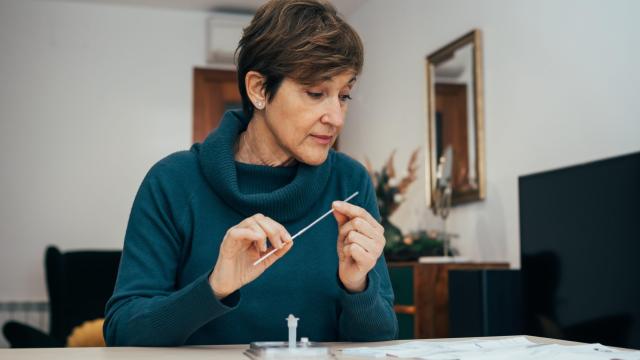At-home rapid tests for COVID-19 instruct you to stir a cotton swab inside each nostril before sliding the swab into its little testing tube or card. But some people have posted pictures on social media comparing a negative at-home nasal swab with a positive at-home throat swab, and even some experts are saying that the throat swabs are more likely to pick up an early infection. But the real story is a bit more complicated.
You see, the at-home tests were only validated for nasal samples. If they turn out to be able to reliably detect the COVID virus in throat swab samples, that would be great — but we don’t know yet if we can rely on those results. To understand what’s going on with the throat swab situation, I called Susan Butler-Wu, a clinical microbiologist at the University of Southern California whose work focuses on tests for infectious disease.
A throat swab, Butler-Wu says, “is going to be right some of the time; but what percentage of the time is it wrong?” The only way to know would be to do a study comparing this new way of testing with the results you get from other tests. “In the laboratory when we come up with a new test, we don’t just start using it. We have to validate it and make sure that it works, and that there are no interfering substances.”
The specifics matter
Tests can produce unreliable results when you use them in a different way than they were designed to handle. For example, students figured out that cola and fruit juice can trick rapid tests into delivering a “positive” result.
If you drank a Coke right before taking your throat swab, could that throw off the results? Maybe! It’s also possible that the cells or chemical compounds that are naturally present in your throat might behave differently in the test than the ones in your nose. We don’t have enough data to say for sure. Maybe the throat swabs are more reliable — that’s possible! — but it’s also possible that they’re less reliable.
Just because a bunch of people have posted their throat and nose swabs to TikTok and Twitter does not mean that the scientific community has seen enough evidence to conclude that throat swabs are your best bet. “We can’t practice lab medicine by anecdotes,” Butler-Wu says. “We need data.”
The reason rapid tests started using nasal swabs instead of throat swabs in the first place was that, earlier in the pandemic, data comparing the two found that the nasal swabs were more likely to pick up the virus. That may have changed with Omicron, and some early data suggests that it has, but it’s too soon to conclude that we need to change our testing protocols. (And remember, Omicron isn’t the only variant out there.)
Tests also differ from brand to brand in how sensitive they are, and in the exact chemistry they use to detect the virus. So even if one brand of test would turn out to be pretty reliable when used with throat swabs, that doesn’t guarantee that the same would be true of others.
And one more complicating factor: We’re having a COVID surge right now. If throat swabs were likely to produce false positives — which, again, we don’t know for sure — those would be overwhelmed by all the real positives. You’re positive, I’m positive, everybody’s positive! But later on, when the surge is over, any given positive would be more likely to be a false positive. (If this sounds confusing, we have a little explainer here. It’s about a different type of test but the underlying issue is the same.) So it may not be a good idea to draw conclusions from recent anecdotes and expect everything to behave the same way in the future.
So what should you do?
I wrote to a few of the rapid test manufacturers, and got brief responses back that pointed out that their tests are FDA-authorised for nasal samples only. As you might expect, the FDA itself has taken the stance that tests should only be used as authorised, no matter how promising the throat swab situation may look. Abbott, the maker of the BinaxNOW tests I saw in so many social media posts comparing nose and throat samples, said in their email that “To help ensure accurate test results, [it] is important to follow the instructions for use.”
Butler-Wu says that if you do a throat swab, or a combined nose-and-throat swab, it’s important to understand that the results may not be accurate. If your test is positive, she says, “I would seek confirmatory testing but assume I have COVID until I get the test back.” Likewise, if your test is negative, you shouldn’t assume that you’re in the clear; rapid tests miss a lot of real infections, especially early on.
In addition, you should be aware that things you eat and drink could potentially affect the results of a throat swab. Since nobody has done a study on exactly how much cola you would have to drink to throw off a test, instructions for throat-swab tests (which do exist for other testing protocols) typically ask you not to eat or drink for at least 30 minutes before taking your swab.
“The issue is, we can’t base recommendations on anecdotes,” Butler-Wu told me. There’s just not enough data to know how reliable throat swabs really are. So if you choose to do one anyway, you should know those limitations.

Leave a Reply
You must be logged in to post a comment.